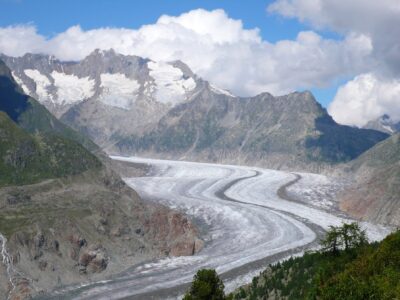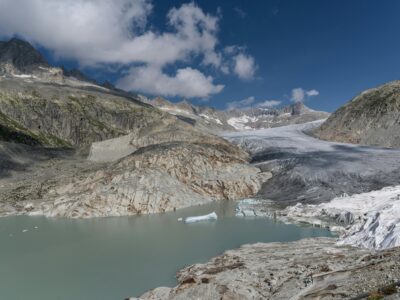Summer 2022 heat waves smashed temperature records throughout the Northern Hemisphere. In Europe, temperatures spiked in Spain, Portugal, France and elsewhere. The United Kingdom experienced the hottest day ever recorded (104°F/ 40°C) in its history. Rising temperatures have increased the number of mountain landslides occurring in Europe. The heat wave also affected East Asia, particularly China and Korea, and South Asia, especially India and Pakistan. These countries experienced increased mortality and sharp drop-offs in crop yields.
The heat waves have also led to the collapse of several glaciers around the world, which were already suffering due to rising global temperatures. Glacier collapses are characterized by large pieces of ice that suddenly break away from the glacier, causing an avalanche or landslide in cases of mountain glaciers. These pieces of ice are large enough that they compromise the glacier’s structure, causing it to continue to break until minimal ice remains.

In the Italian Dolomites, the heat wave led to a total glacier collapse on July 3 after temperatures climbed to 50 degrees Fahrenheit. This summer’s heat waves are not the beginning of glacial disappearance in the Dolomites; rather, glaciers in the Dolomites had already shrunk 30% in volume from 2004 to 2015. Additionally, glaciers that begin to show warning signs of possible collapse often maintain a higher sensitivity to increased temperatures during the summer months. Italy has lost 25% of its glacier meltwater in the last 20 years, and the trend is likely to continue following the recent collapse.
In Asia, a heat wave caused a July 8 glacier collapse in the mountains of Kyrgyzstan. This event triggered an avalanche that missed killing a group of hikers by a matter of minutes. Central Asia experienced an intense heat wave last summer, causing large portions of that glacier to melt and destabilize.
A third glacier — central Switzerland’s St. Annafirn Glacier — is not long for the world as a result of the summer heat waves. St. Annafirn was categorized as a small glacier: small glaciers make up 80% of all Swiss glaciers, yet there is minimal research on them when compared to data collected for larger glaciers. Since 1850, St. Annafirn had lost over 80% of its total surface area, and a significant portion of the loss occurred in the last 40 years. As a result of this summer’s abnormally high temperatures, the glacier is disappearing faster than anticipated.
Glaciers are essential parts of the hydrological cycle and of habitats for a wide variety of organisms; however, they also stir something deep within the human spirit, allowing them to connect with nature in a unique way. Glaciers have long served as key features in Indigenous cultures, particularly in oral traditions and in rituals. Tourism is another source of interaction between humans and glaciers, but the increase in frequency of landslides and glacial collapses threatens tourists traveling to glaciers. Ice stabilizes mountain materials, and increased melting due to rising atmospheric temperatures makes glacial excursions increasingly dangerous. Patterns of glacial disappearance are not unique to Switzerland, Italy, or Kyrgyzstan, but rather are occurring on a global scale.
Mylène Jacquemart is a geologist with the Earth and Science Observation Center at the University of Colorado at Boulder, specializing in remote sensing techniques that help us understand the effects of climate change. In an interview with GlacierHub, Jacquemart expressed the importance of reducing emissions. “Rapid climate action to reduce CO2 emissions is the only thing that will preserve glaciers,” she said. Rapid climate action includes everything from legislative regulation of carbon emissions to supporting carbon sequestration initiatives. She added that the case of total collapse in the Dolomites was rare, but “there is always some residual risk when we are adventuring in mountain regions.”
In 2021, annual carbon emissions were up to 36.3 billion tons, the highest in history. Carbon emissions are still increasing in 2022, and glacial melting will only worsen as a result. This summer’s heat wave serves as a dramatic lesson, prompting multiple unexpected changes all at once. In light of the multiple glacier melting events this summer, it is painfully clear that we must prioritize minimizing carbon emissions to protect and maintain glaciers globally.




I live in Portugal, summer is an absolute nightmare, it is so warm you can only stay at home or beneath available shadows, it has been raining less and less every winter, sometimes it looks as if you are in space, there are no clouds for weeks. Developed nations have used and abused natural resources, there are ways out but we consciously rule them out or are not brave enough.
Unfortunate to hear about the loss of many glaciers, however, this paints a good example of just how damaging climate change has become in the 21st century and the need to address emissions. It is also important to realize how glacier melt and other consequences of rapid warming are affecting communities who have long relied upon local ecosystems. In our approach to solving climate issues it is important to include community stakeholders who are being most affected by climate change. Great article!